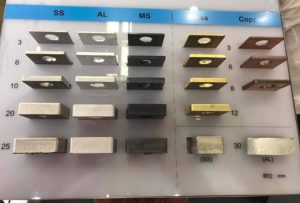Fiber Laser Cutting Process: Factors Affecting Laser Edge Finish-Karina
Fiber Laser Cutting Process: Factors Affecting Laser Edge Finish
There are several factors that affect the laser cutting process. The laser machine itself, the operator, the surface to be cut — every single element plays an important role in regards to the final result of the cut edge finish quality. That being said, the type of the material and its thickness are the two most crucial factors.

Surface Thickness
The quality of the cut edge depends equally on the material and on its thickness. The thicker the sheet, the more prominent the formed striations. These striations are formed due to the fact that the molten parts of the metal come in contact with the cold parts and the difference in temperature forms these striations. They affect negatively the finish of the cut edge. The thicker the material, the bolder the striations. For example, the following striations are formed from a CO2 laser machine:
These striations are responsible for the tolerance achievable. For example, in steel sheets less than 1.0mm thick, it’s suggested to offer +/- 0.12mm, in 10mm steel the repeatable tolerance would increase to +/-0.25mm and steel at 20mm thick you should be maintaining +/-0.75mm tolerances.
Lazer Gücü
One way to enhance the quality of the the cut edge and to reduce the formed striations is to use higher powered laser machines. By using lasers with higher power beams we are able to cut thicker metallic sheets easier and faster, having a better quality cut edge.
Laser Technology
The latest technology advancements and the progress in fiber lasers have bolstered the competition between the all-so-popular CO2 lasers and the newcomer Fiber Lasers. Fiber lasers offer increased cutting speeds in comparison to CO2 lasers while they maintain a higher quality cut edge in the corners and on the material surface.
Nonetheless, the cut edge quality notably decreases the thicker the material is.
Material Type
The material type covers the largest spectrum of the different factors
that affect the laser cut edge, with the most important one the type
of the metal itself.
Different metals feature different properties and they react in a different manner when they are being machined by lasers.
The composition and the metal mixture at hand play an important role in the cut edge finish. The levels of of carbon, manganese, silicon, phosphorus and sulphur can all have a bearing on the surface quality provided by laser cutting. For example, the higher the carbon content in mild steel the rougher the cut edge will become.
Material Quality
The quality of the material can affect the laser cut quality drastically. It is advise to only use clean metals without rust or other oils. Low quality metals can prove quite problematic to cut with lasers. Impurities of low grade metals may cause laser cutting problems and diminish the quality of the end result.
Hot rolled steel is another type of machine metal
that is difficult to laser cut due to its surface scale. There’s a high chance the surface will melt in with the metal itself causing poor quality laser cut edges. The surface needs to be as smooth as possible,
free of imperfections otherwise the laser beam focus can be reflecte
affecting the cleanness and the quality of the cut.
You should try to find “laser grade” or “laser ready” steel which
is specifically machine for laser cutting and engraving purposes.
More info, contact us freely!
Email: xintian103@xtlaser.com
Skype: xtlaser103
Whatsapp/Wechat: 008618206584205




